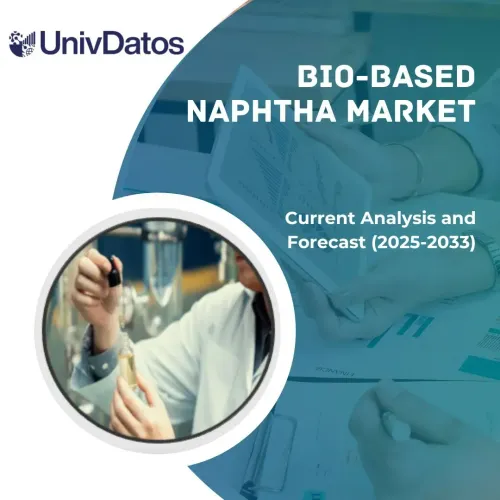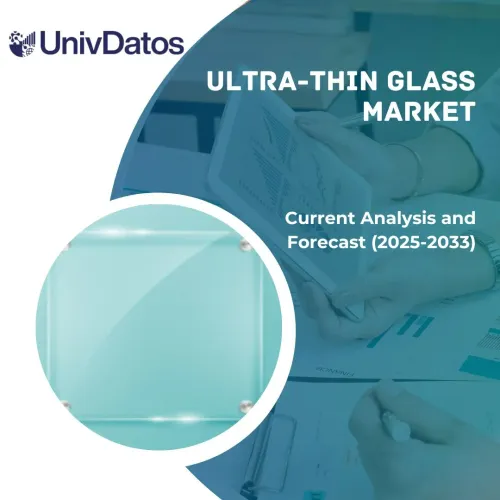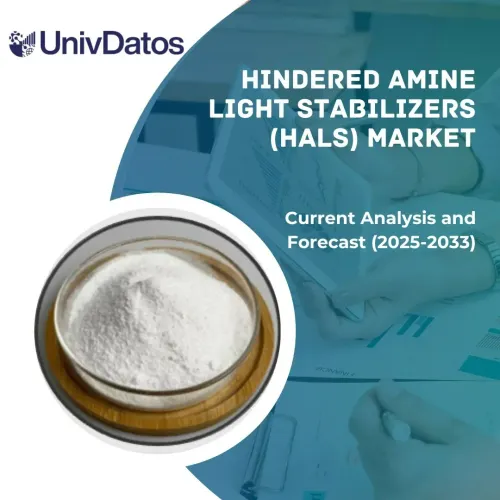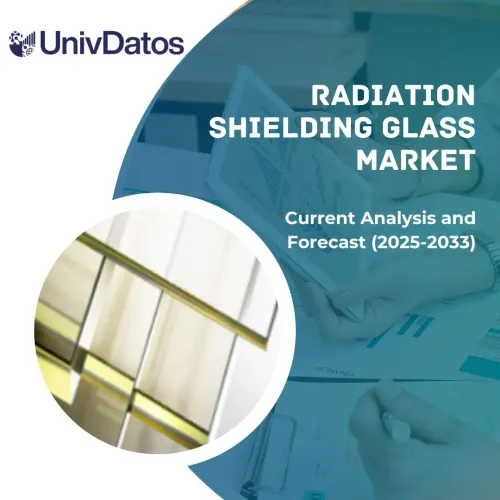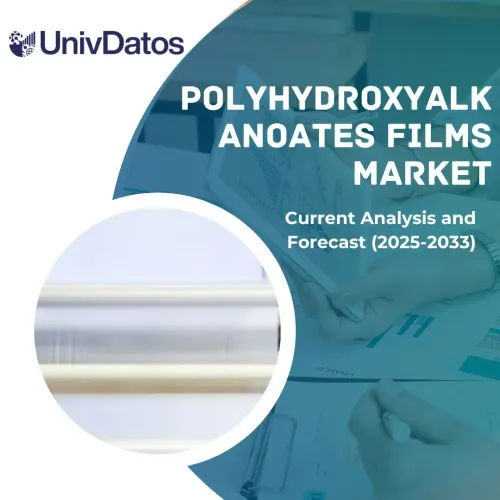MENA 電気透析市場:現状分析と予測 (2024-2032年)
設計の重点(スパイラル巻線構造、プレート&フレーム構造)。エンドユーザー(製薬、発電、化学、電子&半導体、その他)。国
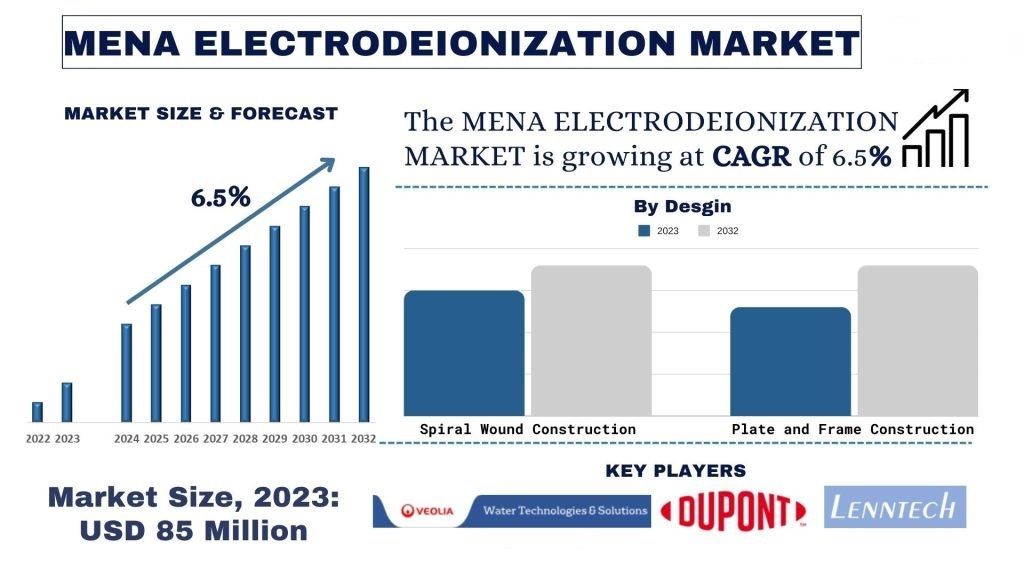
メナ電気透析市場規模と予測
電気透析市場は2023年に8,500万米ドルと評価され、予測期間(2024年~2032年)中に6.5%のCAGRで成長すると予想されています。より迅速かつ正確な臨床試験の必要性が高まっているため。
メナ電気透析市場分析
電気透析(EDI)は、イオン交換と電気伝導の原理を組み合わせて水からイオンと不純物を除去する水浄化技術です。このプロセスは、溶解した塩類やその他の不純物を水から効果的に分離し、さまざまな産業、製薬、および研究室用途に適した高純度の水を生成します。これにより、化学物質の使用量、廃棄物の発生量、および運用コストが削減され、EDIは持続可能で費用対効果の高い水処理ソリューションになります。
この地域での持続可能な水処理ソリューションへの注目の高まりは、水不足と環境への懸念が原因です。これに加えて、製造、ヘルスケア、半導体などの分野での急速な産業成長により、EDIのような効率的な水浄化技術の必要性が高まっています。さらに、水不足問題の深刻化により、システムの効率と性能を向上させるために、改良された膜、自動化、デジタル化など、EDI技術の継続的な進歩が必要となっています。
世界銀行によると、2023年までに、MENA地域の一人当たりの年間利用可能水量は、絶対的な水不足の閾値である一人当たり500立方メートルを下回り、人口が増加するにつれて、問題はさらに深刻になります。
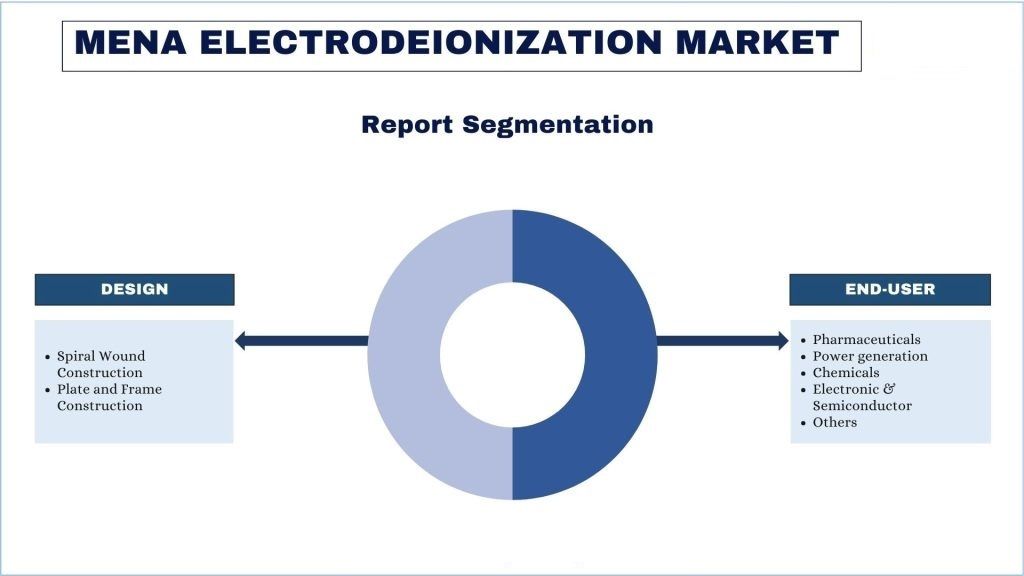
メナ電気透析市場の動向
このセクションでは、当社の調査専門家チームが特定した、電気透析市場のさまざまなセグメントに影響を与えている主要な市場動向について説明します。
発電による産業変革
水は発電プロセスにおいて重要な要素であり、ボイラー給水、冷却システム、および蒸気生成に使用されます。発電産業は、MENA地域における電気透析(EDI)の成長の重要なトレンドであり、特に火力発電所、複合サイクル発電所、および原子力発電施設においてそうです。したがって、水の純度と品質は、発電設備の効率、信頼性、および寿命に直接影響します。
UAEの淡水化発電所には以下のようなものがあります:
- アブダビのシュウェイハットS2発電および水プラントは、1510メガワット(MW)の電力と1億インペリアルガロン(MIGD)の水を1日に生産する能力を持っています。
- ドバイのジェベル・アリ発電所は、UAE最大の発電および淡水化プラントであり、2060MWの電力と140MIGDの水を生産できる6つのガスタービンを備えています。
- フジャイラのF2プラントは、2850MWの電力容量と230MIGDの水を生産できるグリーンフィールドの発電および海水淡水化プラントを持っています。
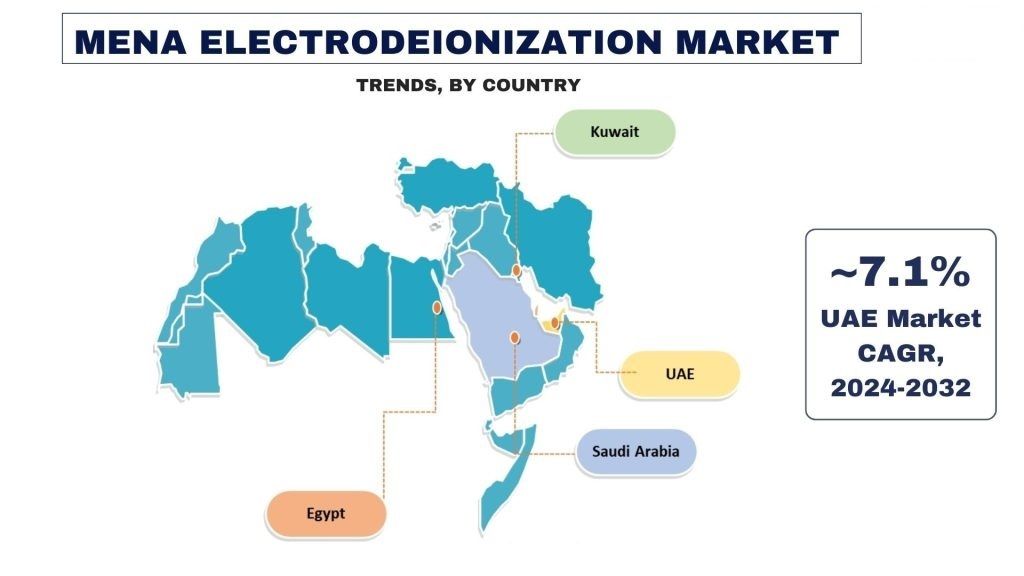
エジプトは予測期間中に大幅なCAGRで成長すると予想されています
エジプトは、予測期間(2024年~2032年)中に大幅なCAGRで成長すると予想されています。製薬業界の成長に伴い、厳格な規制要件を満たし、製品の品質と安全性を確保するために、高度な水処理ソリューション(EDIなど)に投資する製薬会社が増えています。さらに、エジプト企業と国際的なEDIソリューションプロバイダーとの協力により、水処理部門における技術移転、知識交換、および能力開発が促進され、エジプトにおけるEDI技術の採用と成長がさらに促進されています。
たとえば、2023年3月31日、エジプトとアフリカ開発銀行グループは半世紀以上にわたってパートナーです。エジプトではこの枠組みの中で100以上の事業が展開され、多くの戦略的セクターで60億ドル以上が動員されました。
アブ・ラワーシュ水処理プラント(ARWWTP)は、エジプトで2番目に大きい廃水処理プラントであり、世界トップ10の1つです。その建設は、アフリカ開発銀行から1億5,000万米ドルの資金援助を受けました。
電気透析産業の概要
電気透析市場は競争が激しく、細分化されており、MENAおよび国際的な市場プレーヤーが多数存在します。主要なプレーヤーは、パートナーシップ、契約、コラボレーション、新製品の発売、地理的な拡大、およびM&Aなど、市場でのプレゼンスを強化するためにさまざまな成長戦略を採用しています。市場で活動している主要なプレーヤーには、Veolia、DuPont、Pall Corporation、Lenntech B.V.、Pure Aqua, Inc.、Complete Water Solutions、TORAY INDUSTRIES, INC.、IEI、Hydrochemya、Ocean Gateなどがあります。
メナ電気透析市場ニュース
- たとえば、2024年3月:Zawyaのレポートによると、エジプトのスエズ運河経済区(SCZONE)の責任者は、海水淡水化プラントの入札プロセスを開始するプロジェクトを正式に発表しました。昨年7月、SCZONEはウォーターポンプ製造センターの建設を発表しました。
- たとえば、2020年9月:国立産業開発センターは、サウジ水パートナーシップ会社と協力協定を締結しました。これは、水の安全保障を改善し、増大する水需要を満たすために水淡水化装置を製造および重点的に取り組むことを目的としています。
メナ電気透析市場レポートの対象範囲
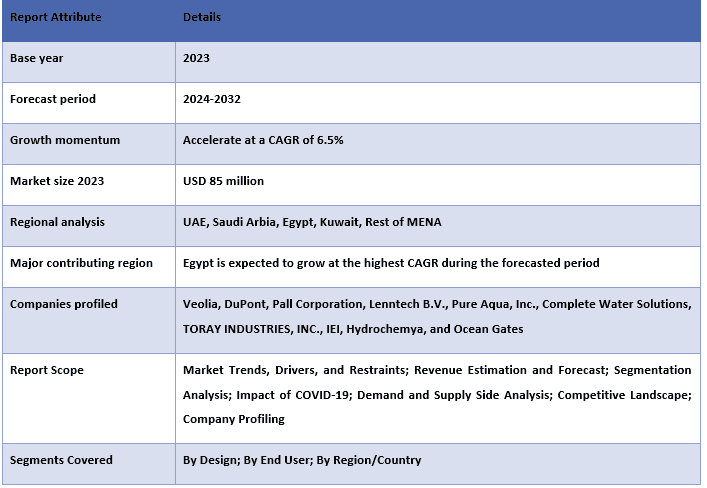
このレポートを購入する理由:
- この調査には、認証された主要な業界専門家によって検証された市場規模の測定および予測分析が含まれています。
- このレポートは、業界全体のパフォーマンスの概要を一目で示します。
- このレポートは、主要なビジネス財務、製品ポートフォリオ、拡大戦略、および最近の開発に重点を置いて、著名な業界同業者の詳細な分析を網羅しています。
- 業界に存在する推進要因、制約、主要なトレンド、および機会の詳細な検討。
- この調査では、さまざまなセグメントにわたる市場を包括的に網羅しています。
- 業界の詳細な地域レベル分析。
カスタマイズオプション:
MENA電気透析市場は、要件またはその他の市場セグメントに応じてさらにカスタマイズできます。これに加えて、UMIは、お客様が独自のビジネスニーズをお持ちであることを理解しているため、お客様の要件に完全に適合するレポートを入手するために、お気軽にお問い合わせください。
目次
メナ電気透析市場分析の調査方法(2024年~2032年)
MENA電気透析市場の過去の市場を分析し、現在の市場を推定し、将来の市場を予測することは、MENAの主要地域における電気透析の採用を創出し分析するために行われた3つの主要なステップでした。徹底的な二次調査を実施して、過去の市場数値を収集し、現在の市場規模を推定しました。次に、これらの洞察を検証するために、多数の調査結果と仮定を考慮しました。さらに、MENA電気透析市場のバリューチェーン全体にわたる業界の専門家との徹底的な一次インタビューも実施しました。一次インタビューを通じて市場数値を仮定および検証した後、トップダウン/ボトムアップアプローチを採用して、完全な市場規模を予測しました。その後、市場の内訳とデータの三角測量方法を採用して、関連する業界のセグメントとサブセグメントの市場規模を推定および分析しました。詳細な方法論を以下に説明します:
過去の市場規模の分析
ステップ1:二次情報源の詳細な調査:
電気透析市場の過去の市場規模を取得するために、企業内の情報源(例:年次報告書および財務諸表、業績プレゼンテーション、プレスリリースなど)、および外部の情報源(例:学術誌、ニュース&記事、政府刊行物、競合他社の刊行物、セクターレポート、サードパーティデータベース、およびその他の信頼できる刊行物)を通じて、詳細な二次調査を実施しました。
ステップ2:市場セグメンテーション:
電解脱イオン市場の過去の市場規模を取得した後、主要地域の異なるセグメントとサブセグメントの過去の市場洞察とシェアを収集するために、詳細な二次分析を実施しました。主なセグメントには、設計、およびエンドユーザーが含まれています。さらに、その地域でのテストモデルの全体的な採用を評価するために、国レベルの分析が実施されました。
ステップ3:要因分析:
さまざまなセグメントとサブセグメントの過去の市場規模を取得した後、詳細な要因分析を実施して、電解脱イオン市場の現在の市場規模を推定しました。さらに、電解脱イオン市場の設計やエンドユーザーなどの従属変数と独立変数を使用して、要因分析を実施しました。世界中の電解脱イオン市場セクターにおける主要なパートナーシップ、合併と買収、事業拡大、製品発売を考慮して、需要と供給の両方のシナリオについて徹底的な分析が行われました。
現在の市場規模の推定と予測
現在の市場規模の測定:上記の3つのステップからの実用的な洞察に基づいて、現在の市場規模、MENA電解脱イオン市場の主要プレーヤー、およびセグメントの市場シェアに到達しました。必要なすべてのパーセンテージシェア分割と市場内訳は、上記で言及された二次アプローチを使用して決定され、一次インタビューを通じて検証されました。
推定と予測:市場の推定と予測のために、ドライバーとトレンド、制約、およびステークホルダーが利用できる機会を含むさまざまな要因に重みが割り当てられました。これらの要因を分析した後、トップダウン/ボトムアップアプローチなど、関連する予測手法を適用して、主要市場MENA全体のさまざまなセグメントとサブセグメントについて、2030年の市場予測に到達しました。市場規模を推定するために採用された調査方法論は、以下を含みます:
- 収益(USD)の観点からの業界の市場規模と、主要市場全体での電解脱イオン市場の採用率
- 市場セグメントとサブセグメントのすべてのパーセンテージシェア、分割、および内訳
- 提供される製品の観点からのMENA電解脱イオン市場の主要プレーヤー。また、この急速に成長している市場で競争するために、これらのプレーヤーが採用した成長戦略
市場規模とシェアの検証
一次調査:主要地域全体で、トップレベルの幹部(CXO / VP、営業責任者、マーケティング責任者、運用責任者、地域責任者、カントリーヘッドなど)を含む主要オピニオンリーダー(KOL)との詳細なインタビューが実施されました。一次調査の結果が要約され、定量的分析が実施されて、述べられた仮説が証明されました。一次調査からのインプットは二次調査の結果と統合され、それによって情報が実用的な洞察に変わりました。
さまざまな地域における一次参加者の内訳
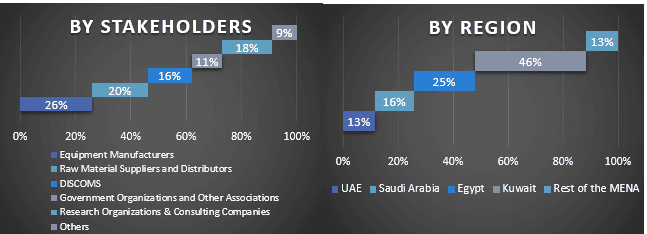
市場エンジニアリング
データ三角測量技術は、全体的な市場推定を完了し、MENA電解脱イオン市場の各セグメントとサブセグメントの正確な統計数値を出すために採用されました。データは、MENA電解脱イオン市場の設計およびエンドユーザーの分野におけるさまざまなパラメータとトレンドを調査した後、いくつかのセグメントとサブセグメントに分割されました。
MENA電解脱イオン市場調査の主な目的
MENA電解脱イオン市場の現在および将来の市場トレンドが調査で特定されました。投資家は、調査で実施された定性的および定量的な分析に基づいて、投資に対する裁量を決定するための戦略的洞察を得ることができます。現在および将来の市場トレンドは、地域レベルでの市場の全体的な魅力を決定し、産業参加者が未開拓市場を利用して、ファーストムーバーの利点を享受するためのプラットフォームを提供します。調査のその他の定量的目標には、以下が含まれます。
- 電解脱イオン市場の現在の市場規模と予測市場規模を金額(USD)で分析します。また、さまざまなセグメントとサブセグメントの現在の市場規模と予測市場規模を分析します
- 調査のセグメントには、設計およびエンドユーザーの分野が含まれます
- 電解脱イオン業界の規制枠組みの定義と分析
- さまざまな仲介業者の存在に関連するバリューチェーンを分析し、業界の顧客と競合他社の行動を分析します
- 主要地域の電解脱イオン市場の現在の市場規模と予測市場規模を分析します
- レポートで調査された地域の主要国には、アジア太平洋、ヨーロッパ、北米、および世界のその他の地域が含まれます
- 電解脱イオン市場の企業プロファイルと、急速に成長している市場で持続するために市場プレーヤーが採用した成長戦略
- 業界の詳細な地域レベル分析
よくある質問 よくある質問
Q1: 電気脱イオン市場の現在の市場規模と成長の可能性は?
Q2: 電気脱イオン市場の成長の推進要因は何ですか?
Q3: 設計別の電気脱イオン市場で最大のシェアを占めるセグメントは?
Q4: 電気脱イオン市場における新興技術とトレンドは何ですか?
Q5: どの地域が電気脱イオン市場を支配しますか?
関連 レポート
この商品を購入したお客様はこれも購入しました

